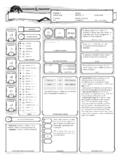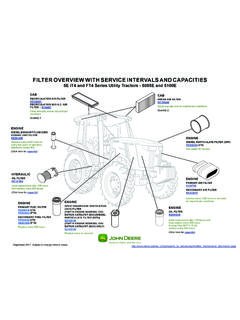Transcription of Why Cat 5e, Cat 6 or Cat 6A? - Cable Monkey
1 Issue 8 2014 Connectix E&OEUpdated 27/01/14 Category or ClassCategory 5 was first published as a standard in 1995 and Category 5e came along in 1995. It appeared in: ANSI/TIA/EIA-568-A EN 50173 ISO 11801 Note that in the American standard (TIA) the term Category refers to the individual product performance (cables and connectors etc) and the overall channel performance. For example Category 5e defines a range of electrical performances up to 100 MHz. However, in the European standard, EN 50173 and the international ISO standard, Category only refers to individual product performance. The overall link and channel performance is rated by Class.
2 So for example a Cat 5e Cable terminated with Cat 5e connecting hardware would give a Class D channel and link performance. Cat 5e Channel corresponds to Class D Channel Cat 6 Channel corresponds to Class E Channel Cat 6A Channel corresponds to Class EA ChannelHowever, it is also worth noting that although the performance requirements for TIA and EN ISO are very similar, there are still slight differences between Category and Class .What They Have in Common?All Cat 5e, Cat 6 and Cat 6A cables use 4 twisted pairs in a common jacket. They use the same style RJ45 Jacks and Plugs. They can all use shielded twisted Cable (STP) orunshielded twisted pair (UTP) cables.
3 The channel is limited to a length of 100 metres including the length of patch cables on either end of the link. The connectors are backward compatible. For instance, you may use Cat 5e connectors for a Cat 6 permanent cabling link. Your system will perform at a level of the lowest link, in this case Cat 5e. Up to 2013, the standards for all three of Cat 5e, Cat 6 and Cat 6A are as follows: ANSI/TIA/EIA-568-C EN 50173 ISO 11801 Cat 5eThe original Category 5 standard was suitable for LAN transmission standards up to 155Mb/s, including all the various forms of fast Ethernet up to 100Mb/s. When Gigabit Ethernet was introduced in 1998 it was discovered that the original Cat 5 specification wasn t good enough to guarantee error-free performance.
4 Extra technical requirements were added to the original Cat 5 specification, such as Return Loss, Delay, Delay Skew and Power Sum Crosstalk measurements to ensure reliable operation of Gigabit Ethernet. The improved range of parameters became known as Enhanced Category 5 or Cat 5e. Cat 5 has long been superseded by Cat 5e. The electrical performance for Cat 5e requirements is up to Cat 5e, cat 6 or cat 6A?Issue 8 2014 Connectix E&OEUpdated 27/01/14 Cat 5e Link Performance Requirements (TIA)Cat 6 Category 6 was designed as the next generation of cabling to Cat 5e. Cat 6 requires more demanding electrical parameters than Cat 5e, up to 250 MHz rather than 100 MHz for Cat 5e. It is a higher performance system, supporting more than double the frequency with 250 MHz and running to a higher specification.
5 This gives it significant performance headroom to support the faster protocols and is therefore considered more reliable than Cat 5e. It is also suitable for Gigabit Ethernet 6 Link Performance Requirements (TIA)Cat 6 ACat 6A cabling is higher performance with requirements up to 500 MHz in frequency and is designed to support 10 Gigabit transmission over the full 100 metre channel. It is also backwards compatible with Cat 6 and Cat 5e. A new electrical parameter measure of alien crosstalk was introduced to ensure that the Cat 6A cabling system can properly run 10 Gigabit transmission. The alien crosstalk is a measurement of the noise crosstalk generated from neighbouring cables, which was initially not a concernfor Cat 5e and Cat 6 whose frequency was up to 100 MHz and 250 MHz respectively.
6 However due to operating at a higher frequency of 500 MHz for Cat 6A it is important to consider the alien crosstalk Twisted Pair (STP) cabling system with shielding effect can prevent most of the noise from neighbouring cables and is preferable for a Cat 6A system. A specially designed Unshielded Twisted Pair (UTP) cabling system is also available to mitigate the alien crosstalk. However in terms of cost, the UTP system could be similar or more costly than the STP system since the cost of the specially designed UTP Cable is relatively high. Up to date, the STP system is more popular and widely accepted for Cat 6A system in 6A Link Performance Requirements (TIA)What Are The Differences?
7 Cat 6A has a better transmission performance than Cat 6 and Cat 5e. In turn, the higher grade of the system, the less signal loss, the less cross talk, and wider frequency bandwidth. These are all electrical performance differences, not meaning the speed of the network performance. Using a higher grade of cabling system such as Cat 6A doesn t necessarily lead to a faster network. The network speed is decided by the transmission equipment such as a network switch. A network switch will negotiate the fastest link it can manage out of 10 Mbit/s, 100 Mbit/s, 1 Gbit/s or 10 Gbit/s. It will start by trying for the best speed it is able to find. If the cabling system and receiving end can t handle the speed, it will start to drop down to the next designated speed until the entire link can support the speed.
8 Hence for GigabitFrequency100 MHz250 MHz500 MHzInsertion 8 2014 Connectix E&OEUpdated 27/01/14transmission we use Cat 5e or Cat 6 system and for 10 Gigabit we use Cat 6A Cat 5e and Cat 6 supports Gigabit Ethernet. The advantage for Cat 6 over Cat 5e is that it gives more headroom in terms of performance and is more reliable than Cat 5e as it provides room for error. However, Cat 6 takes up more space for installation and is more costly than Cat 5e. Cat 5e is still extensively used more than any other system in the Ethernet 10 Gigabit transmission, Cat 6A is the best option. However, to date, 10 GBase-T switches and relative interfaces are still new, expensive and power hungry.
9 Most users are choosing Cat 5e or Cat 6 on the basis that they are perfectly capable of running Gigabit Ethernet. This is more than adequate for most users for the forseeable future. The Cat 6A system will take off when computers and network equipment is equipped with 10 Gigabit interfaces. It is then that the 10 Gigabit bandwidth will be fully exploited and its potential fully understood. Hence the argument for a Cat 6A system is that it is future proof. Cost and space is still a big challenge for Cat 6A which needs much more space for installation than Cat 6 and is also much more expensive. However, for a data centre, computer room and backbone cabling where transmission speed and bandwidth is demanding, Cat 6A is now a popular option against fibre since it is cheaper and mechanically more robust than fibre.
10 Cat 6A might not be able to compete with 10 Gigabit fibre for long links over 100m such as long distance main backbone Cable but it has proved to be very reliable in data centres where links are usually under 100m.






